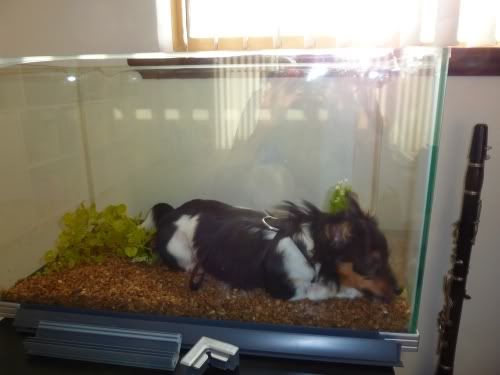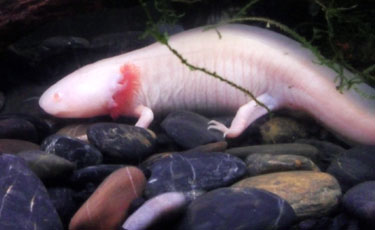So I have wanted an axolotl for my entire life and am finally in a position where I can have one. I'm a bit short on money and I was going to wait for christmas but now I've gotten really excited about it and been looking into it and realised it might not actually cost that much (and it's become apparent my step-mum is terrified of axolotls, so a christmas present is unlikely).
So I just had some questions to make sure I've got everything covered.
I have a tank (a score from hard rubbish collection ), it's 60cm long, 35cm tall and 30cm wide, which I think I remember calculating to be about 10 or 11 gallons, which is apparently enough for one axolotl? It doesn't have a lid, will I need one? I read some stuff about axolotls jumping out of their tanks, but is there a certain amount of space I can keep between the top of the water and the top of the tank to avoid that?
), it's 60cm long, 35cm tall and 30cm wide, which I think I remember calculating to be about 10 or 11 gallons, which is apparently enough for one axolotl? It doesn't have a lid, will I need one? I read some stuff about axolotls jumping out of their tanks, but is there a certain amount of space I can keep between the top of the water and the top of the tank to avoid that?
This is a picture of the tank, with a small dog (she wont be in there with the axolotl):

The gravel is obviously too small for an axolotl. I have been reading about it and I really don't like the idea of a bare bottom or sand, or having to buy pebbles, however - there is some kind of pointless pit of pebbles in the entrance way of my house, and they appear to be exactly the same as the ones in this picture:

Can I just use those? Would an axolotl like those? Would my landlord freak out when she notices my axolotl has the same pebbles (or "river rock") as the entrance way?
I read about putting a layer of sand below river rock like that, should I do that? And where do I get this "play sand" from?
Can I leave those plastic plants in there for the axolotl?
I live in Australia (Perth), do I need a heater? Or should I get a thermometer incase it gets too hot?
What do I need to test for water quality? How much does that cost?
There's a pet shop that has a whole range of filters in a whole range of prices. I have no idea what the different kinds of filters are, which ones are appropriate for an axolotl and which aren't? I can only remember that the "under gravel" filter was the cheapest (like $15 for my size tank), would that one be okay for an axolotl/my gravel-thing?
I saw a little aquarium cave at kmart for $6, is there like a minimum measurement for the entrance/inside of a cave for an axolotl?
What's the youngest/smallest you can/should get axolotls?
Is it better (or possible) to find a breeder or are petshop axolotls basically the same?
Do all axolotls grow to 30cm long? I met one that was 8 years old and only like 15-20cm. If they can be different sizes, can you tell how big they'll grow when they are babies?
What can I do with my axolotl when I have him?
Is this all I'll need for an axolotl? I've never had any kind of aquatic creature before. :happy:
So I just had some questions to make sure I've got everything covered.
I have a tank (a score from hard rubbish collection
This is a picture of the tank, with a small dog (she wont be in there with the axolotl):

The gravel is obviously too small for an axolotl. I have been reading about it and I really don't like the idea of a bare bottom or sand, or having to buy pebbles, however - there is some kind of pointless pit of pebbles in the entrance way of my house, and they appear to be exactly the same as the ones in this picture:

Can I just use those? Would an axolotl like those? Would my landlord freak out when she notices my axolotl has the same pebbles (or "river rock") as the entrance way?
I read about putting a layer of sand below river rock like that, should I do that? And where do I get this "play sand" from?
Can I leave those plastic plants in there for the axolotl?
I live in Australia (Perth), do I need a heater? Or should I get a thermometer incase it gets too hot?
What do I need to test for water quality? How much does that cost?
There's a pet shop that has a whole range of filters in a whole range of prices. I have no idea what the different kinds of filters are, which ones are appropriate for an axolotl and which aren't? I can only remember that the "under gravel" filter was the cheapest (like $15 for my size tank), would that one be okay for an axolotl/my gravel-thing?
I saw a little aquarium cave at kmart for $6, is there like a minimum measurement for the entrance/inside of a cave for an axolotl?
What's the youngest/smallest you can/should get axolotls?
Is it better (or possible) to find a breeder or are petshop axolotls basically the same?
Do all axolotls grow to 30cm long? I met one that was 8 years old and only like 15-20cm. If they can be different sizes, can you tell how big they'll grow when they are babies?
What can I do with my axolotl when I have him?
Is this all I'll need for an axolotl? I've never had any kind of aquatic creature before. :happy:



